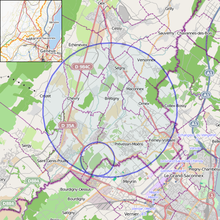
Back Groot Hadronversneller Afrikaans مصادم الهدرونات الكبير Arabic زداح لكبير د لهادرونات ARY বৃহৎ হেড্ৰ'ন সংঘৰ্ষক Assamese Gran colisionador d'hadrones AST Böyük adron sürətləndiricisi Azerbaijani Вялікі адронны калайдар Byelorussian Вялікі гадронны калайдэр BE-X-OLD Голям адронен ускорител Bulgarian বৃহৎ হ্যাড্রন সংঘর্ষক Bengali/Bangla

The Large Hadron Collider (LHC) is the world's biggest and most powerful particle accelerator. It was built by the European Organization for Nuclear Research (CERN). It is a giant circular tunnel built underground. The tunnel is 17 miles (27 kilometers) long, and between 50 and 175 meters below the ground.[1] It lies beneath the border of Switzerland and France. 10,000 scientists and engineers from over 100 different countries worked together in the making of this project, and it cost 10.4 billion Swiss francs ($10 billion) to build.[2] It is now the largest and most complicated experimental research facility in the world.
As its name states, the research at the LHC involves the collision of hadrons. A hadron is a particle which consists of a number of quarks held together by the subatomic strong force. Protons and neutrons are examples of a hadron. The LHC primarily uses the collision of protons in its experiments.[3] Protons are parts of atoms with a positive charge. The LHC accelerates these protons through the tunnel until they reach nearly the speed of light.[1] Different protons are directed through the tunnel in opposite directions. When they collide, they create conditions similar to the early universe.[3]
The LHC attempts to study elementary particles and the ways they interact. Researchers have used it to learn about quantum physics, and they hope to learn much more about the structure of space and time. The observations researchers are able to make can help us learn what the universe might have been like within milliseconds after the big bang.
- ↑ 1.0 1.1 "LHC Machine Outreach". Retrieved 2010-05-02.
- ↑ "Large Hadron Collider: Best- and Worst- Case Scenarios". Wired Magazine. September 9, 2008. Retrieved 2010-01-31.
- ↑ 3.0 3.1 Science and Technlogy Facilities Council. "STFC Web Site." Large Hadron Collider. Research Coucils UK, n.d. Web. 12 May 2014. <http://www.stfc.ac.uk/646.aspx Archived 2014-05-16 at the Wayback Machine>.